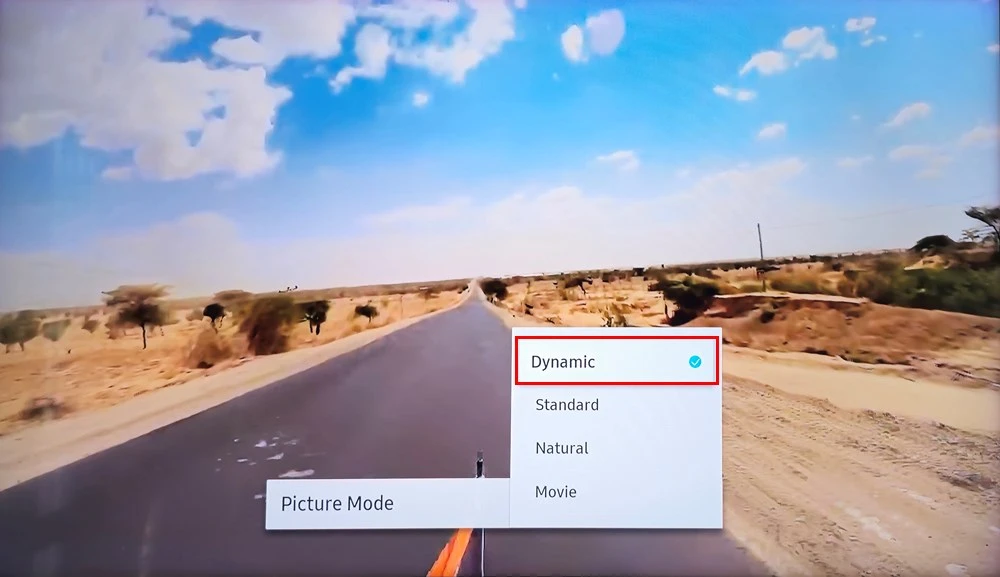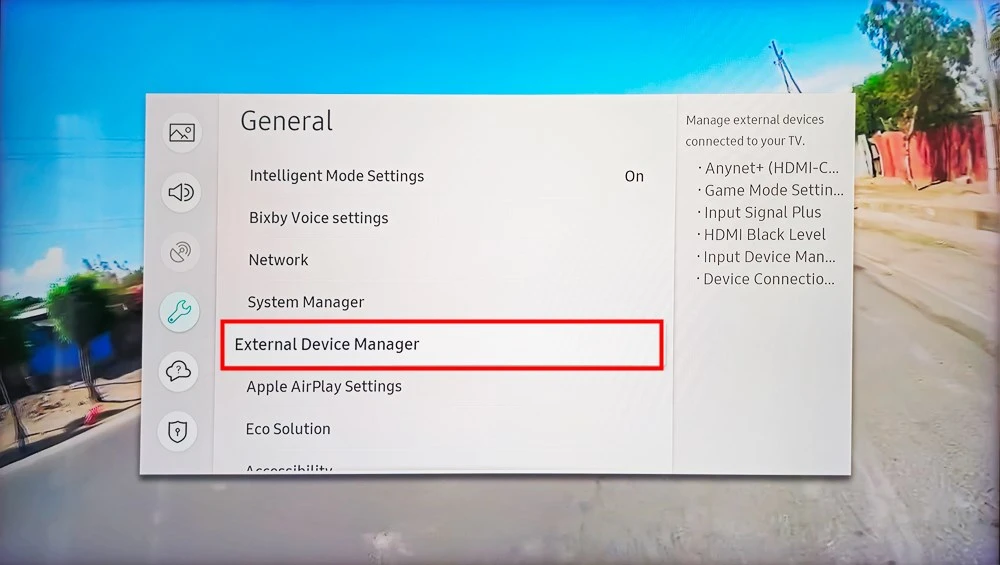Samsung TVs are known for their excellent picture quality. However, you can enhance your viewing experience to the optimum level by applying the best picture settings for Samsung 4K and UHD TVs with LED and QLED screens. Whether you use your TV for watching channels, streaming OTT content, or gaming, the tips to optimize the picture quality will help you get the most out of it.
The ideal picture settings may differ depending on the room lighting conditions. For instance, if you watch TV in a bright room with natural or artificial light, keep the brightness, contrast, sharpness, color, and backlight on the higher side. However, if your TV is in a dark room, keep the brightness, color, and sharpness below 50% for better picture quality.
Samsung TV Picture Modes
LG TVs offer more picture mode presets than Samsung’s. You would find only four picture modes on Samsung TVs.
- Dynamic: If your TV is placed in a room with bright or natural light, you’ll need heightened brightness, contrast, colors, and sharpness. When your Samsung TV is in dynamic mode, it will have a bright and vivid picture, too much saturation, and unbalanced black levels. If the Dynamic mode is enabled, you may experience eye fatigue while watching TV in low-light conditions. It consumes more electricity than all other picture modes.
- Standard: This mode offers a balanced viewing experience with moderate brightness, color, contrast, and sharpness, and is best suited for normal lighting conditions.
- Natural: If you prefer less brightness, color, contrast, and sharpness than the Dynamic and Standard modes, the Natural picture mode should suffice your needs as it is good for eye comfort as well. Since Samsung TVs don’t have an option like LG’s Eye Comfort Mode, you should check my guide to learn how to enable the blue light filter on your Samsung TV.
- Movie: This picture mode adds a warm tone to the picture and offers subdued levels of brightness, contrast, sharpness, and color that are perfect for watching TV in low light or a dark room. Since the Movie mode disables any extraneous picture processing, it’s good for watching movies with smoother motion.
Expert Picture Settings on Samsung TVs
Apart from the default picture modes, Samsung TVs also have Expert Settings that let advanced users tune the picture settings to their taste. Depending on your Samsung TV model number, the picture settings may differ.
- Auto Motion Plus Settings or Picture Clarity Settings: Enhance picture sharpness to optimize fast-moving images. Switching to the custom configuration allows you to adjust blur reduction and judder reduction and turn on LED Clear Motion.
- Backlight: This picture setting lets you decide how much light your TV screen produces. An ideal configuration depends on the lighting conditions of your room. If the room is dark, keep it in the lower range and vice versa.
- Brightness: Adjust the brightness of the screen.
- Color: Adjust the saturation level of colors on your screen.
- Color Space Settings: Refine the spectrum of colors on your screen. Under custom settings, you can define the color range displayed on your screen and adjust the saturation level of red, green, and blue.
- Color Tone: Configure the color tone that suits your viewing preferences.
- Contrast: Adjust the dark and light elements of the display.
- Contrast Enhancer: Automatically balances the contrast to prevent excessive differences between bright and dark areas.
- Digital Clean View: Turning on this option reduces picture noise and distractions such as flickering. While this setting is irrelevant for HD and UHD content, it can improve your viewing experience with sources like analog cable TV, VHS, and DVD.
- Dynamic Contrast: If you turn on this picture setting on your Samsung TV, it’ll automatically adjust the contrast ratio to balance the differences between dark and light portions of the screen. Thus, it artificially enhances the content on the screen.
- Film mode: Make frame transitions from older video sources smoother. This function is only available when the input is from sources like TV, AV, or HDMI (1080i).
- Gamma: Configure the mid-range brightness of the picture.
- HDMI Black Level: Adjust the black level for HDMI input for better picture brightness and contrast.
- RGB Only Mode: Adjust the red, green, and blue channels to define your preferred saturation and tint level.
- Sharpness: Fine-tune how sharp your picture should appear.
- Smart LED: Adjust the LED brightness and dimming level for better picture quality.
- Tint (G/R): Control how much green and red tint you want.
- White Balance: Using this setting, you can fine-tune the appearance of the white color on your TV. If you think that white things on your TV screen have a red, green, or blue tint, you can adjust the Red Offset and Gain, the Green Offset and Gain, and the Blue Offset and Gain. Depending on your TV model, you may have 2-point, 10-point, or 20-point white balance settings. By adjusting these settings, you can make whites appear brighter.
Picture Settings for QLED and Neo QLED TV
If you have a Samsung QLED TV or its model number starts with ‘Q’, you can try the following picture settings for balanced picture quality for the Samsung QLED TV series with 4K and 8K screens.
| Expert Settings | Value |
|---|---|
| Picture mode | Movie |
| Backlight | 15 |
| Brightness | 0 |
| Contrast | 75 |
| Sharpness | 5 |
| Color | 28 |
| Tint (G/R) | 0 |
| Apply Picture Settings | All sources |
| Digital clean view | Off |
| Auto Motion Plus Settings | Off |
| Contrast Enhancer | High |
| Film Mode | Auto1 |
| Color Tone | Warm2 |
| Gamma | 2.2 |
| Color Space Settings | Auto |
| White balance | 2 Point |
| Red Gain | 9 |
| Green Gain | -5 |
| Blue Gain | -8 |
| Red Offset | 0 |
| Green Offset | 1 |
| Blue Offset | 3 |
Picture Settings for Samsung 4K UHD TV
On a Samsung UHD TV with 4K resolution, use the picture settings below. Please note that the best value for Backlight might differ depending on the lighting environment.
| Expert Settings | Value |
|---|---|
| Backlight | 5-6 |
| Brightness | 0 |
| Contrast | 85 |
| Sharpness | 5 |
| Color | 45-55 |
| Tint (G/R) | G50/R50 |
| Use Picture Settings | All sources |
| Digital clean view | Off |
| Auto Motion Plus Settings | Off |
| Contrast Enhancer | Off |
| Local Dimming | Low |
| HDR+ Mode | Off |
| HDMI UHD Color | On for HDR HDMI sources |
| Color Tone | Warm2 |
| Gamma | BT.1886 |
| Color Space | Auto |
| White balance | 2 Point |
| Red Gain | 8 |
| Green Gain | -5 |
| Blue Gain | -9 |
| Red Offset | 5 |
| Green Offset | 8 |
| Blue Offset | 5 |
SUHD & LED TV Picture Settings
If you own a Samsung SUHD TV with an LED screen, try the picture settings below for optimal results.
| Picture Settings | Value | |
|---|---|---|
| Picture | Profile | Movie |
| Backlight | 8 | |
| Contrast | 80 | |
| Brightness | 45 | |
| Sharpness | 35 | |
| Color | 45-55 | |
| Tint | G50/R50 | |
| Advanced | Dynamic Contrast | Off |
| Black tone | Off | |
| Flesh tone | 0 | |
| Color space | Auto (native for DCI-P3) | |
| White balance | 2 Point | |
| – Red | 4 | |
| – Green | 3 | |
| – Blue | -5 | |
| + Red | 5 | |
| + Green | 0 | |
| + Blue | -5 | |
| Gamma | 0 | |
| Picture settings | Color tone | Warm2 |
| Digital Clean View | Off | |
| MPEG noise filter | Off | |
| Movie | Off | |
| Auto Motion Plus | Blur | 5 |
| Judder | 0 | |
| LED Clear | Off or On (with the backlight on max) | |
| Smart LED | Standard |
Best Picture Settings for Gaming
If you want to enjoy the best possible gaming experience on your Samsung TV by connecting to a gaming console like PlayStation or Xbox, you must tweak the picture settings. It doesn’t matter whether you own an LED (SUHD/UHD), QLED, or Neo QLED (4K/8K) from Samsung; you need to enable Input Signal Plus and Game Mode.
Once you’ve turned on those settings, the TV screen will be optimized for low latency while using a gaming console. Moreover, the color, sharpness, and contrast will be enhanced to optimize fast-moving objects.
- Open your Samsung TV Settings.
- Navigate to General > External Device Manager.

- Now, click on Game Mode Settings and turn it on.
- When the Game Mode is on, enable Game Enhancer and set the Dynamic Black Equalizer value to 4.
- Then click on Game Motion Plus Settings and enable Game Motion Plus.
- Set Blur Reduction to 8 and Judder Reduction to 9.
- Make sure that LED Clear Motion is turned off.
Additional Settings for Gaming on Samsung TV
Turn on HDR+ Mode
Some Samsung Smart TVs come with HDR (High Dynamic Range) Mode. When enabled, HDR+ Mode will add more shades of color than that of normal mode even if your Gaming Console does not support HDR.
- Just open Settings > Picture.
- Navigate to Expert Settings and enable HDR+ Mode.
Turn On the Input Signal Plus
- Open Settings > General and select External Device Manager on your Samsung Smart TV.
- Now, click Input Signal Plus and enable it for the HDMI port to which your gaming console is connected.
You are all set to enjoy gaming on your Samsung TV with enhanced colors, smooth motion, less judder and blur, and low latency.
Samsung TV Dark Screen Fix
If you think your Samsung TV is too dark and even tuning the backlight setting is not working, try the following tip. This solution will also work if your TV screen dims or brightens by itself.
On New Samsung TVs
Go to Settings > General > Eco Solution and turn off the following items:
- Ambient Light Detection
- Energy Saving Mode
- Motion Lighting
On Older Samsung TVs
Navigate to Screen Menu > System > Eco Solution > Eco Sensor and turn it off.
This will fix the Samsung TV dark screen issue.
Fixing Samsung TV Blue Tint/Hue Issue
One of our visitors recently had this issue. His Samsung TU8000 Crystal UHD TV had a bluish hue or tint regardless of channel or app. He tried adjusting the picture settings, but it didn’t help. If you are having this problem as well, try the following tip.
- Press the Home button on your Samsung TV remote.
- Navigate to Settings and select it.
- Then go to Picture > Expert Settings.
- Look for a setting named RGB Only Mode and turn it off.
- If you don’t find this setting, select the Reset Picture option.
The blue tint problem on your Samsung Smart TV will be fixed if it doesn’t have any hardware issues.
Read Next: Fix Samsung TV Error Codes 0-1, 001, 012, 102, 105, 107, 301
